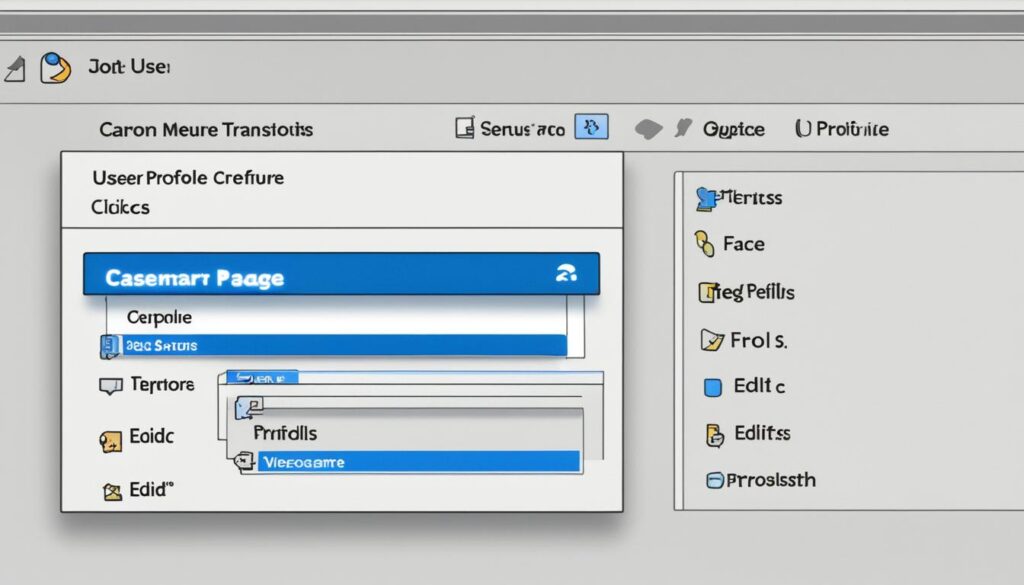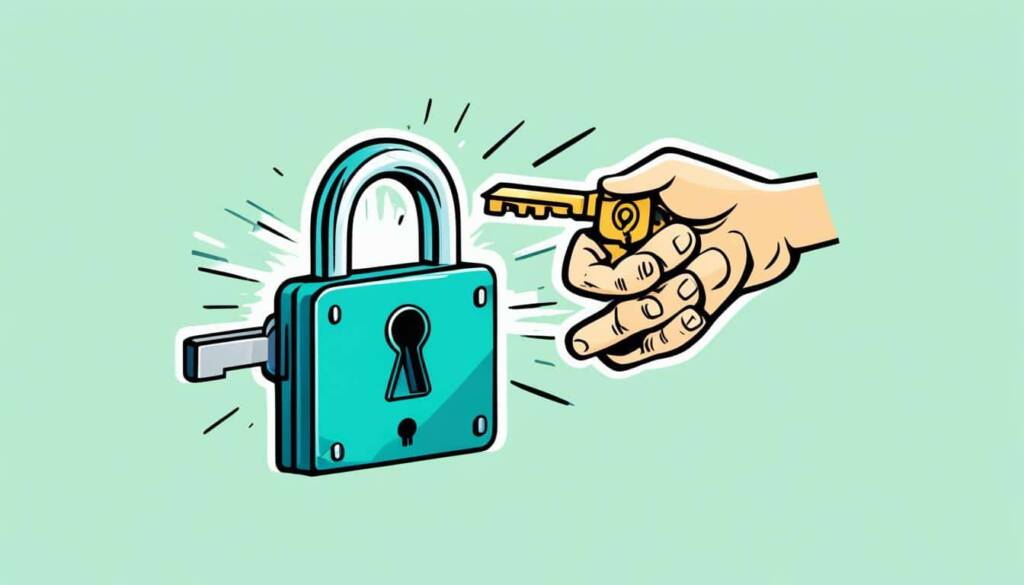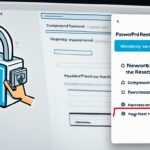Table of Contents
Are you concerned about the security of your WordPress website? One of the simplest and most effective ways to protect your website is by regularly changing your WordPress password. In this easy guide, we will walk you through the step-by-step process of changing your WordPress password to ensure the utmost security for your website.
Whether you suspect a security breach or simply want to take proactive measures, changing your WordPress password is a crucial step. By following the instructions provided in this guide, you can quickly update your password and keep your website safe from unauthorized access.
Key Takeaways:
- Regularly changing your WordPress password is an important part of maintaining website security.
- Following this easy guide will help you navigate to the user profile page to update your password.
- Utilize strong and secure passwords to enhance your website’s protection.
- Remember to change your password periodically to effectively safeguard your WordPress site.
- Implementing password best practices is crucial for preventing unauthorized access to your website.
Accessing Your WordPress Dashboard
Before you can change your WordPress password, you need to access your WordPress dashboard. Here, we’ll explain how to log in to your WordPress account and navigate to the dashboard.
To access your WordPress dashboard, follow these steps:
- Open a web browser and go to the WordPress login page.
- Enter your WordPress username or email address in the designated field.
- Next, enter your password. Make sure to use a strong password to protect your account.
- Click on the “Log In” button to proceed.
Once you’ve successfully logged in, you will be redirected to your WordPress dashboard. This is the control panel for your website, where you can manage your content, customize your site’s appearance, install plugins, and much more.
Tip: Bookmark the WordPress login page for easier access in the future.
“The dashboard is like the heart of your WordPress site. It’s the place where you can make all the changes and updates necessary to keep your website running smoothly.” – WP Expert
If you encounter any issues while logging in, double-check that you’ve entered the correct username or email address and password. Also, ensure that your caps lock key is disabled, as WordPress passwords are case-sensitive.
WordPress Dashboard Overview
Once you’ve logged in to your WordPress dashboard, you’ll see a user-friendly interface with a range of features and options. Here are some key elements you’ll find in the WordPress dashboard:
| Element | Description |
|---|---|
| Dashboard | Your main control panel, providing an overview of your website’s activity, including recent posts, pending comments, and site statistics. |
| Posts | Allows you to create, edit, and manage your blog posts and articles. |
| Media | An area where you can upload and organize images, videos, and other media files for your website. |
| Pages | Enables you to create and manage static pages on your site, such as the About Us and Contact pages. |
| Appearance | Allows you to customize your site’s appearance by selecting themes, customizing menus, and managing widgets. |
| Plugins | Provides access to a wide range of plugins that enhance the functionality of your website. |
| Users | Enables you to manage user accounts, including adding new users and assigning different roles and permissions. |
| Settings | Allows you to configure various settings for your website, including general, writing, reading, and discussion settings. |
Exploring and familiarizing yourself with these elements will help you effectively manage and customize your WordPress website.
Once you’re in the WordPress dashboard, you’ll need to locate the user profile page to change your password. Here, we’ll guide you through the process of finding the user profile page.
To navigate to the user profile page, follow these steps:
- From the WordPress dashboard, locate the menu on the left-hand side.
- Within the menu, look for the “Users” option. It may be listed under the “Settings” or “Appearance” sections.
- Click on the “Users” option to expand the submenu.
- Within the submenu, select “Your Profile” or a similar option that refers to your own user profile.
By following these steps, you will be directed to your WordPress user profile page, where you can make changes to your account settings, including your password.
Note: The exact location of the user profile page may vary depending on the version of WordPress or any customizations you have made to your dashboard. If you are having trouble locating the user profile page, consult your website administrator or refer to the WordPress documentation for further assistance.
Pro Tip:
Save time navigating to the user profile page by using the search bar in the WordPress dashboard. Simply type “User Profile” or relevant keywords to quickly access your user profile settings.

| Step | Action |
|---|---|
| 1 | From the WordPress dashboard, locate the menu on the left-hand side. |
| 2 | Within the menu, look for the “Users” option. It may be listed under the “Settings” or “Appearance” sections. |
| 3 | Click on the “Users” option to expand the submenu. |
| 4 | Within the submenu, select “Your Profile” or a similar option that refers to your own user profile. |
Changing Your WordPress Password
Now that you’re on the user profile page, it’s time to update and change your WordPress password. Follow these simple steps to ensure the security of your website:
- Step 1: Locate the “Password” section on the user profile page.
- Step 2: Click on the “Generate Password” button to have WordPress create a strong password for you.
- Step 3: If you prefer to set your own password, delete the automatically generated one and enter your new password in the designated field. Make sure the password meets the criteria for a strong and secure password.
- Step 4: Confirm your new password by entering it again in the “Repeat Password” field.
- Step 5: Click the “Update Profile” button to save your new password.
Remember to choose a strong and unique password to keep your WordPress account secure. Use a combination of uppercase and lowercase letters, numbers, and special characters. Avoid using common phrases, names, or personal information that can be easily guessed.
Pro Tip: Use a password manager to securely store and manage your passwords. This will make it easier to generate strong passwords and keep track of them without the risk of forgetting.
Take a moment to update your WordPress password now to ensure the protection of your website and sensitive information.
| Advantages of Changing Your WordPress Password | Disadvantages of Not Changing Your WordPress Password |
|---|---|
| Enhanced security and protection against unauthorized access | Increased vulnerability to hacking attempts |
| Peace of mind knowing your account is secure | Potential compromise of sensitive information |
| Reduced risk of data breaches and cyberattacks | Possible damage to your website’s reputation and user trust |
Best Practices for a Strong Password
When it comes to securing your WordPress website, one of the most important steps you can take is creating a strong and secure password. A strong password helps protect your site from unauthorized access and potential security breaches. Follow these best practices to ensure your WordPress password is robust:
- Use a combination of characters: Create a password that includes a mix of uppercase and lowercase letters, numbers, and symbols. This makes your password more complex and harder to guess.
- Avoid easily guessable information: Do not include personal information such as your name, birthday, or address in your password. Hackers can easily obtain this information and use it to try and gain access to your site.
- Make it lengthy: Opt for longer passwords, ideally with a minimum of 12 characters. The longer the password, the more challenging it becomes for hackers to crack.
- Don’t reuse passwords: Each online account, including your WordPress site, should have a unique password. Reusing passwords across multiple platforms increases the risk of multiple accounts being compromised if one password is exposed.
- Consider using a password manager: Password managers can help generate strong passwords and securely store them for all your online accounts. This eliminates the need to remember multiple complex passwords.
By following these best practices, you can create a strong WordPress password that significantly increases the security of your website. Protecting your site is crucial in safeguarding your data and maintaining the trust of your visitors.
Remember: Changing your WordPress password is a proactive step towards enhancing the security of your website. Don’t underestimate the importance of a strong password!
Key Takeaways:
Creating a strong and secure password for your WordPress website is essential for ensuring the safety of your online presence. Follow these best practices:
- Use a combination of characters
- Avoid easily guessable information
- Make it lengthy
- Don’t reuse passwords
- Consider using a password manager
By implementing these recommendations, you can significantly strengthen the security of your WordPress site.
Conclusion
In conclusion, this easy guide has provided you with the necessary steps to change your WordPress password effectively. By following these instructions, you can ensure the security of your website and safeguard your valuable data.
Remember, it is crucial to regularly update your password to stay ahead of potential security threats. By implementing these best practices, such as creating a strong and secure password, you can reduce the risk of unauthorized access to your WordPress account.
Take the time to navigate to your user profile page within the WordPress dashboard and make the necessary changes to your password. By prioritizing the security of your website, you can have peace of mind knowing that you have taken the necessary steps to protect your online presence.
FAQ
How often should I change my WordPress password?
It is recommended to change your WordPress password regularly, ideally every 3 to 6 months. This helps ensure the security of your website and protects it from potential unauthorized access.
Can I change my WordPress password from the WordPress mobile app?
Yes, you can change your WordPress password using the WordPress mobile app. Simply open the app, navigate to the settings or profile section, and look for the option to change your password. Follow the prompts to update your password.
What should I do if I forget my WordPress password?
If you forget your WordPress password, you can easily reset it. On the WordPress login page, click on the “Lost your password?” link. You will be prompted to enter your email address associated with your WordPress account. Follow the instructions sent to your email to reset your password.
Are there any specific requirements for a strong WordPress password?
Yes, it is important to create a strong WordPress password to enhance the security of your website. Here are some best practices for a strong password:
– Use a combination of uppercase and lowercase letters, numbers, and special characters.
– Avoid using common phrases or easily guessable information like birthdays or names.
– Make your password at least 8 characters long.
– Use a unique password for your WordPress account, not one that you use for other online platforms.
How can I check the strength of my WordPress password?
There are various online tools available that can help you check the strength of your WordPress password. These tools assess the complexity and uniqueness of your password and provide a rating or score. It is recommended to use one of these tools to ensure your password is strong and secure.
Can I use a password manager to store my WordPress password?
Absolutely! Using a password manager is a great way to securely store your WordPress password and other login credentials. Password managers encrypt and protect your passwords, allowing you to have strong and unique passwords for all your online accounts without the risk of forgetting them.












